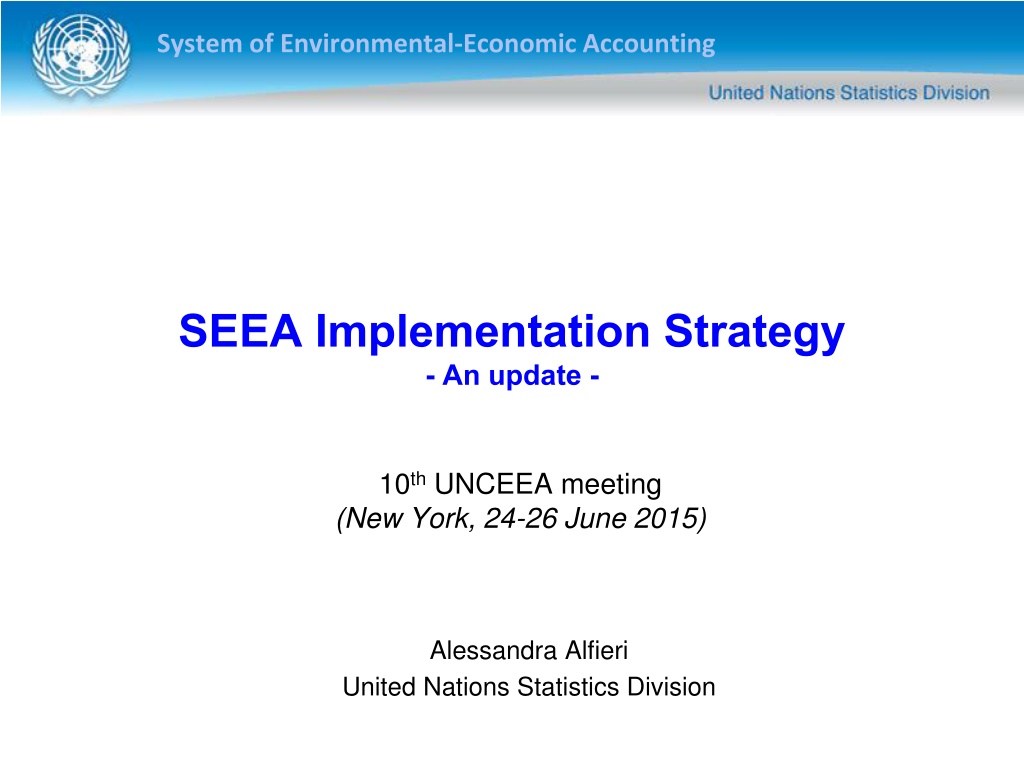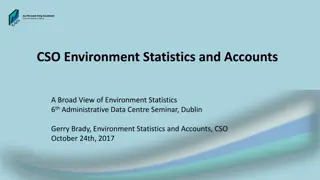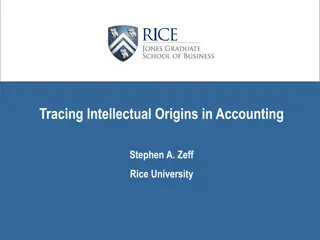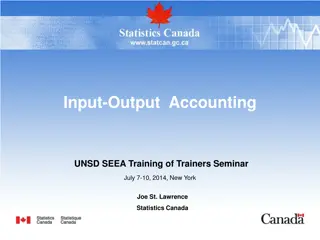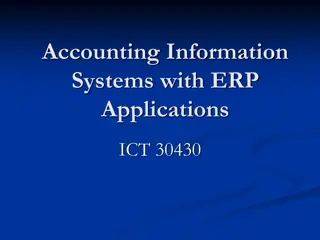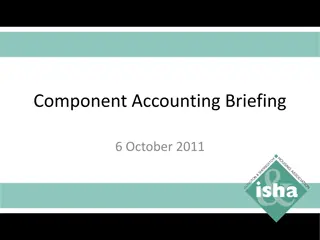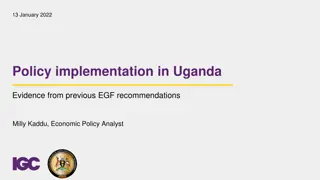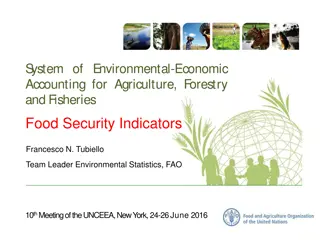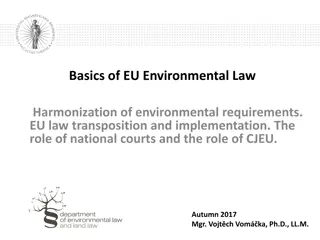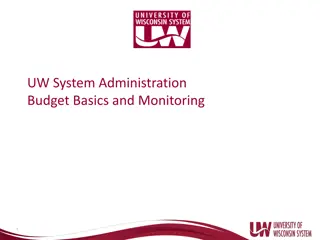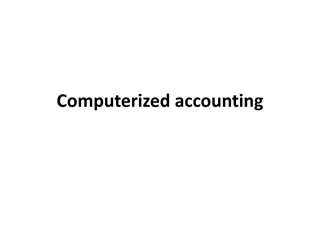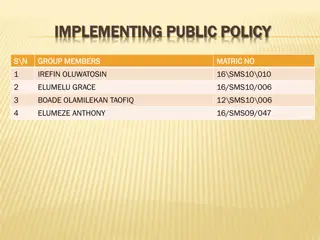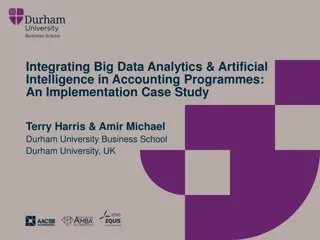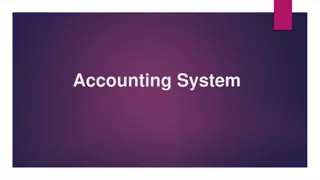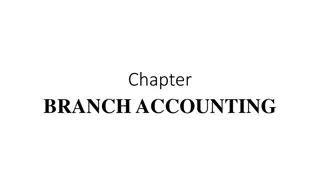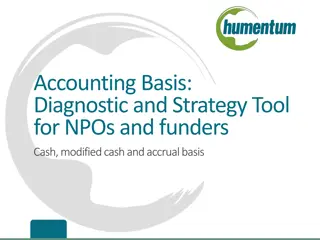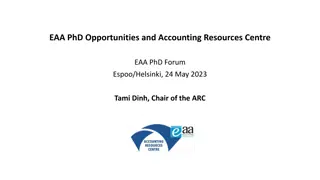System of Environmental-Economic Accounting: Implementation and Policy Landscape
This article delves into the implementation strategy and policy landscape of the System of Environmental-Economic Accounting (SEEA), highlighting key endorsements, frameworks, and initiatives such as SDG integration, green economy strategies, SCP alignment, data initiatives, and the importance of geospatial information. The SEEA serves as a vital statistical framework for reporting on various environmental and economic aspects, playing a crucial role in modernizing the statistical system and promoting sustainable development.
Download Presentation

Please find below an Image/Link to download the presentation.
The content on the website is provided AS IS for your information and personal use only. It may not be sold, licensed, or shared on other websites without obtaining consent from the author. Download presentation by click this link. If you encounter any issues during the download, it is possible that the publisher has removed the file from their server.
E N D
Presentation Transcript
System of Environmental-Economic Accounting SEEA Implementation Strategy - An update - 10thUNCEEA meeting (New York, 24-26 June 2015) Alessandra Alfieri United Nations Statistics Division
System of Environmental-Economic Accounting Background SEEA Central Framework adopted (UNSC 2012) Implementation strategy for SEEA Central Framework endorsed (UNSC 2013) SEEA Experimental Ecosystem Accounting endorsed as as a synthesis on measurement on ecosystems (UNSC 2013) Encouragement to test and experiment with the SEEA EEA for those countries wanting to embark on ecosystem accounting (UNSC 2013) Step up the SEEA implementation in countries (UNSC 2015) Use of big data to complement official statistics (UNSC 2014-15) Transformative agenda and modernization of statistical system (UNSC 2015) GGIM Develop best practices for legal instruments and technical standards on geospatial information
System of Environmental-Economic Accounting Policy landscape SDG Integrated policies in need for integrated information system (SNA, SEEA CF, SEEA EEA can inform many goals and targets) Green economy/Green growth OECD has launched data collection on air emission and subsoil assets with intention to expand to other accounts Beyond GDP/EU strategy for environmental accounting strategy Eurostat has mandatory reporting on: air emission accounts, MFA, EPEA, env. Taxes, energy and EGSS Aichi targets SEEA been recognized as the framework to report on Target 2 and for expenditures on biodiversity Natural Capital Accounting World Bank/WAVES recognizes the SEEA as the underlying statistical framework
System of Environmental-Economic Accounting Policy landscape SCP Efforts are underway to align SCP thematic indicators with SEEA Sustainable tourism Linking Tourism Satellite Accounts and the SEEA GRI and other initiatives on reporting by businesses Analysis of different initiatives and initiate process of alignment
System of Environmental-Economic Accounting Data initiatives SDG indicators Modernization of the statistical system SEEA as a catalyst Big data Use of geospatial data in support of official statistics Baselines GGIM Setting the agenda for geospatial information Geospatial infrastructure and technology
System of Environmental-Economic Accounting Objectives of the SEEA implementation strategy Adoption of the SEEA as the measurement framework for sustainable development Mainstream the SEEA implementation in countries as part of the modernization of the statistical system, including institutional arrangements and regular integrated production process Establish technical capacity for regular reporting on a minimum set of environmental-economic accounts
System of Environmental-Economic Accounting Targets SEEA implementation 2020 100 countries with on-going programmes on SEEA Central Framework and 50 on SEEA Experimental Ecosystem Accounts Comparable global baseline data and indicators to support monitoring and assessment for SDGs Programs and material in place to build capacity International research and education mechanisms Updated SEEA Experimental Ecosystem Accounting
System of Environmental-Economic Accounting Considerations for SEEA implementation Strategic approach to the implementation National Strategies for the Development of Statistics (NSDS) should be linked to strategic planning frameworks such as the National Development Strategies, National Sustainable Development Strategies (NSDS) and National Biodiversity Strategies and Action Plans (NBSAP), National Compacts Linking the implementation to policy demands The SEEA can serve as an important statistical infrastructure in response to existing policy frameworks such as Post 2015 Development Agenda, Natural Capital Accounting and Wealth Accounting and Valuation of Ecosystem Services (WAVES), green economy/green growth, sustainable consumption and Production (SCP), thematic information
System of Environmental-Economic Accounting Considerations for SEEA implementation National ownership countries own the implementation process and agree on national implementation strategies and national plans Sub-regional and regional approach sub-regional organizations have played important roles in bringing together countries, compiling existing statistics, promoting standards and developing capacity in countries and fostering south-south cooperation Capacity building Communication strategy
System of Environmental-Economic Accounting Approach to national implementation Phase I: National Assessment and National Plan Phase II: Programmes of work for priority accounts Phase III: Pilot compilation of priority accounts Phase IV: Data quality assessment and sustainable production of SEEA accounts Training and capacity building Communication and advocacy
System of Environmental-Economic Accounting Global SEEA implementation Coordination Development of tools and materials to support the national implementation Advancing the research agenda Development of baseline for the SDG Communication
System of Environmental-Economic Accounting Coordination Among international agencies Obtain buy-in from the different communities (e.g. water, SCP, forest, etc.) Ensure a coordinated approach to the development of statistical system based on standards, using common tools and approaches Coordinated technical assistance With scientists from academia, think-tanks, etc. Leverage on scientific expertise and mainstream it within the national statistical system
System of Environmental-Economic Accounting Coordination (Cont ed) With the business community Ensure alignment of concepts and methods business accounting with the SEEA to obtain higher quality data from businesses
System of Environmental-Economic Accounting Tools in support of SEEA implementation Training materials (E-learning, workshops, etc.) SEEA implementation guide, compilation manuals, diagnostic tools Technical notes including core sets of SEEA tables for data collection and reporting Creation of E-platform repository of technical and implementation materials and tools in support of the SEEA implementation Regional and sub-regional workshops In-country technical assistance
System of Environmental-Economic Accounting Baselines for SDG indicators SEEA has been recognized as an important framework to inform SDG indicators But there are very few data which are SEEA compliant Opportunity to mainstream the SEEA in the national statistical system In the short term, use available data and try to estimate SEEA compliant indicators using existing data collection and reporting processes, understand differences In the medium term, align the reporting to SEEA or develop standard methods to bridge
System of Environmental-Economic Accounting Strategy for funding National sources to mainstream SEEA as part of the national official statistics programme International agencies to undertake joint fundraising leveraging their strengths NSO with experience on the SEEA implementation to support less experienced countries Close coordination among the agencies to avoid duplication of work and to ensure each technical assistance project fits within a general scheme
System of Environmental-Economic Accounting Roadmap for the SEEA implementation Three streams of work Stream 1 Implementation and testing at the national level Development of national plans Compilation of accounts with available data Development of databases within integrated statistical framework in the medium term Stream 2 Applications and indicators Dissemination of the accounts Application to derive indicators and modeling (IO) Stream 3 Advancing towards common standards Advance research agenda (SEEA CF and SEEA EEA) Towards elevation of SEEA EEA to standard
System of Environmental-Economic Accounting Questions to the Committee 1. Does the UNCEEA agree with the assessment of the current situation as presented in the strategy [Sections I and II]? 2. Does the UNCEEA agree with the objectives, targets and scope of the implementation strategy [Section III]? 3. Does the UNCEEA agree with the approach to national implementation[Section IV]?
System of Environmental-Economic Accounting Questions to the Committee (Cont ed) 4. Does the UNCEEA agree with the approach to global implementation[Section V] and in particular with the suggested proposal for establishing partnerships and draft TOR presented in Annex I and II? 5. Does the UNCEEA agree to the strategy for funding [Section VI]? 6. Does the UNCEEA agree with the proposed roadmap until 2020 [Section VII]?
System of Environmental-Economic Accounting Thank you!
